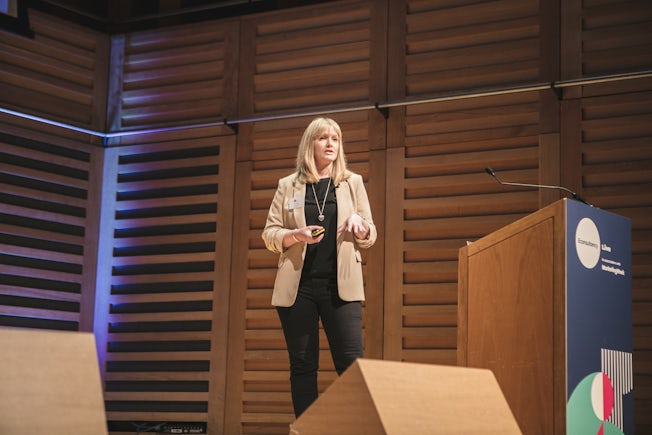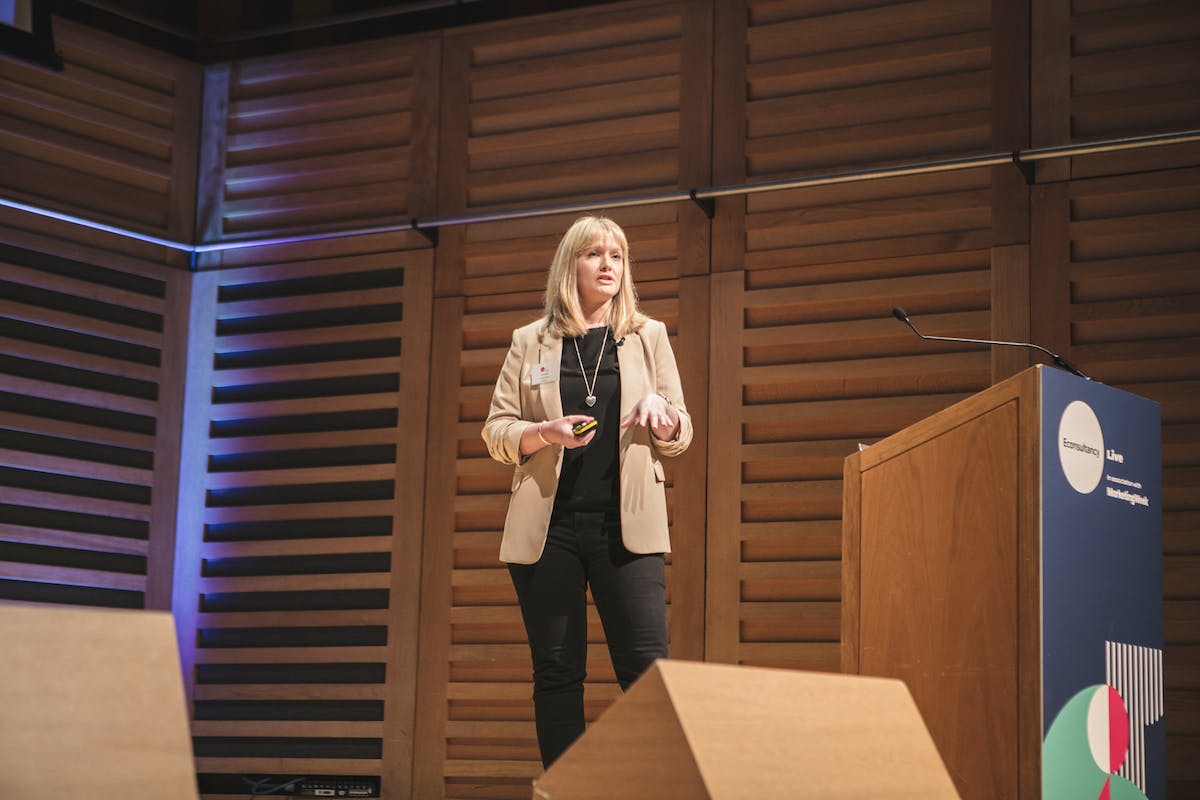In the midst of a mounting cost of living crisis, consumers are more aware of their financial wellbeing than ever – making straightforward, accessible financial services absolutely paramount.
According to research conducted by Legal & General, also known as L&G, 75% of its customer base expect 10 specific top tasks to be simple, intuitive, and available online. However, the cost of living crisis may be creating further barriers to self-service: the Lloyds UK Consumer Digital Index 2022 found that 35% of UK consumers say the rising cost of living is impacting their ability to go online. Ten percent of the UK population also lacked both the digital basics and the essential digital skills for everyday life.
“The whole concept of the connected experience has never been more important,” L&G’s Group Technology Director – Digital and Experience, Claire Hazle, told the audience at Econsultancy Live. “It’s really important that our customers feel in control of their financial wellbeing irrespective of the channel they choose to do it through.”
Hazle illustrated how L&G has evolved towards building connected experiences across multiple systems, geared around key “moments that matter” in their customers’ lives. She also explained how L&G has worked to overcome organisational silos to join up the different services it provides, and how it has used customer journey mapping to tackling issues with its online login as well as its pensions on-boarding process.
Training
Econsultancy offers CX training, including the elearning plan, Mapping the Customer Journey.
Product thinking – just like baking a cake
Customer needs change as they journey between key moments throughout their lives, and the challenge for L&G, explained Hazle, has been to go from a feature development approach towards end-to-end experiences. “The journey between those moments [of customers’ lives] has to be seamless,” said Hazle. “[At L&G] we’re a series of companies under a brand, so there’s a real temptation to work in silos.
“So, the challenge for my team was: how do we actually get around that to create those experiences that cut across products, moments that matter, and also being able to overlay… segmentation and profiling against this as well?”
L&G has adopted a number of unifying experience principles, one of which is service design thinking. “When developing something that would benefit the end consumer, we don’t just look at the front end experience,” said Hazle. “Where possible, we would look all the way through in terms of the processes that sit behind it, so we’re not then creating extra legacy or ‘swivel chair’ processes, which the customer still doesn’t benefit from in the end.”
Another is ‘simplicity’, or perfecting the fundamentals of an experience, which Hazle likened to baking a cake. “You can’t start on icing and sprinkles until you’ve got the sponge right,” she said.
“Our teams really do focus on getting those brilliant basics done – really simply, and really effectively, and that’s when the customer will give you permission to start experimenting and add the extra value, and then the innovation, on top.”
Hazle also emphasised that a product thinking mindset is key to developing customer experiences, “so that you don’t just create something and then leave it, because it then degrades.” However, she added, there is a balance to be struck between customer value and business outcomes: “There’s no point having something that drives value for the business if it doesn’t drive value for the customer.”
L&G is addressing this by evolving its maturity model – a tool used to measure how well a business or product is doing and how capable it is of continuous improvement. A small, core team is responsible for looking at a variety of data such as customer satisfaction data, customer ease scores (i.e. how easy a customer finds it to complete a task), and call centre insight. This is aided by a “focused discovery approach”, using design thinking, service design, and behavioural science to refine insights and balance delivering customer value with delivering business value.
Finally, L&G has assigned a dedicated scrum team to look at optimisation, tasked with identifying challenges and opportunities and focusing on the areas of greatest value for the customer over the next year. “I’m giving them a problem to solve, and that’s really the environment they thrive in, in terms of taking a challenge, looking at a number of different sources of data, owning that challenge and then delivering an outcome,” said Hazle.
“It’s going to be a really interesting year, to see how they get on with that.”

Using customer journey mapping to address failure demand
One major case study that drove both business and customer value for L&G was an initiative to tackle failure demand (customer demand caused by issues with an organisation’s service) produced by customer logins in 2020. In January of that year, L&G was receiving 4.22 calls from customers for every 100 logins – which, as Hazle said, “doesn’t sound like very many, but when you consider the scale of L&G, it’s a lot of people.”
Only 69% of customers were able to successfully log in to their accounts to view their policy – “So it was increasing operational inefficiency and it certainly wasn’t a good experience for customers.” L&G’s long-term vision was to be able to drive up digital adoption and bring more customers online, but the issues with logins needed to be tackled before this would be possible.
“So, what did we do?” asked Hazle. “We spent time mapping out these customer journeys, both across web and across phone; and we used qualitative and quantitative insight to really kind of work out where those pain points were and where those friction points were.”
L&G created a dedicated scrum team and presented them with the problem, asking them to focus on the outcome of a better registration and login experience. “And from that point, we’ve evolved that kind of approach from looking at specific friction points to now starting to look at how we might evolve into offering the customer different choices in terms of resolution,” said Hazle. “So, if they’re getting to a point where they’re struggling rather than pick up the phone, we might then insert something – an FAQ, knowledge-base question content on their call; we might introduce webchat.
“There are different points of contact the customers could choose, to keep them particularly in the digital channel rather than having to pick up the phone.”
L&G also aggregated different customer data sources to achieve a real-time “helicopter view” of the customer experience, integrating online analytics such as Adobe web tracking and Qualtrics, a customer satisfaction online survey, together with the customer journey information and data from offline communications. “So, if we can see then where there’s a pain point in that particular journey, we can then see the communication that’s being driven as a result of that, and then follow that all the way through,” said Hazle. “That’s going to be a really powerful tool for us, I think, to be really cross-channel and have a cross-channel helicopter view.”
The goal was to reduce failure demand to fewer than 1.9 calls per 100 logins, and at the latest count, L&G was receiving 0.71 calls per 100 logins – “so, a really good result there.” Login rates have also been improved to just over 85%. Hazle credited this success in part to the involvement of L&G’s board: although L&G is normally “very, very traditional in terms of securing business case funding”, Hazle approached the board with a request for funding and the outcome that the team would be striving towards, rather than a point-by-point breakdown of deliverables with ROI modelled for each one. “And fair play to our board, it was a leap of faith for them, and they believed in us,” she said. “And of course, the team did it.”
Mapping the pensions on-boarding journey
External services are not the only services that need to have a smooth customer experience. When new joiners arrived at L&G, the company discovered that the on-boarding process for its workplace pension was poor, with many elements that were confusing or unintuitive. “I always say, when people come into the company, it’s really refreshing to get a new person’s view on things, because I think we can get a bit blinded by the problems that we see,” said Hazle.
The team mapped out the pensions new joiner experience, identifying ‘highs’ and ‘lows’ in the customer journey as well as improvements that could be made to address these. Some of the issues identified included letters sent to the customer where an email could have been sent instead, inconsistent language and names used to refer to things, and places where the information that the customer had available to them didn’t match the information required by the registration process. The map also marked the progression of customer sentiment across the journey in response to the scenarios they encountered.

L&G mapped customer sentiment throughout various scenarios along the customer journey, noting where improvements could be made to address challenges that customers encountered. (Image: Legal & General)
“This is kind of a common process that will be used, actually mapping customer sentiment across each of the different touchpoints, along with the channels and what the highs and lows are, and what the customer might be thinking,” Hazle said.
“We actually interviewed a number of our employees to get to this point, and it’s a similar process that we would follow with external customers as well, using a number of different research methods.”
As a result, L&G made a number of improvements to the new joiner experience, thanks to the input that they’d received from new starters in the company. “It’s really helpful to keep that research constant and tap into new joiners as they come into the company,” Hazle noted, “because it gives you that fresh perspective.”
By employing customer journey mapping for a company internal process in the same way they would do for an external service, L&G were able to alleviate a business challenge for new joiners, thereby improving employee experience (EX) – which goes hand in hand with good customer experience.
For training on CX, explore our Deep Dive Channel.


Comments